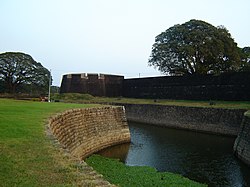Palakkad Fort
| Palakkad fort (Tippu's fort) | |
|---|---|
 | |
| Location | Palakkad, Kerala, India |
Palakkad Fort also known as Tipu sultan's Fort is an old fort situated in the heart of Palakkad town of Kerala state, southern India. It was built by Haider Ali in 1766 ACE and remains one of the best preserved forts in Kerala.
History
The Palakkad Fort is said to have existed from very ancient times, but believed to be constructed in present form in 1766 A.D, but little is known of its early history. The local ruler, Paliyath Achchan, was originally a tributary of the Zamorin, but had become independent before the beginning of the eighteenth century.[1] In 1757 he sent a deputation to Haider Ali seeking help against an invasion threatened by the Zamorin. Hyder Ali seized upon the opportunity to gain possession of a strategically important location such as Palghat, and from that time until 1790 the fort was continually in the hands of the Mysore Sultans or the British. It was first taken by the latter in 1768 when Colonel Wood captured it during his raid on Hyder Ali's fortresses, but it was retaken by Haider a few months later. It was recaptured by Colonel Fullarton in 1783, after a siege that lasted eleven days but was abandoned the following year. It later fell into the hands of the Zamorin’s troops. In 1790 it was finally captured by the British under Colonel Stuart. It was renovated and was used as a base for operations that ended with the storming of Srirangapatnam. The fort continued to be garrisoned until the middle of 19th century. In the early 1900s it was converted into a taluk office.[2]
The fort is also known as Tipu's Fort (after Tipu Sultan, the son of Hyder Ali).
Current status
There is a large ground between the Fort and the Palakkad Town hall, known as Kota Maidanam (Fort Grounds). The ground, which had once served as a stable for the elephants and horses of Tipu's army, is now used to stage cricket matches, exhibitions and public meetings. An open air auditorium called "Rappadi", currently under the preservation of the Archeological Survey of India, is also located within the spacious grounds of the Fort. Additionally, there is a children's park on one side of the Fort.
Interior
The Palakkad Special Sub Jail is also located within the fort. There is a small shrine called Anjaneya Swamy Temple inside the fort. A garden called Vatika-Shilavatika is maintained inside the court.
Related locations
This description needs additional citations for verification. (March 2011) |
This article possibly contains original research. (March 2011) |
It is said that Hyder Ali had plan to build the famous Palakkad Fort here, before it is built in its present location. Granite and rocks are kept here for constructing the fort. But the plan was changed and the fort was constructed at Palakkad. The resulted massive plain land was used by the people of nearby villages as a market of ancient times. Since then this area is known as 'Kottachantha' of which 'Kotta' means Fort and 'Chantha' means Market in malayalam language.
It is believed that the name of the next village, Kottayi (I and II), is derived from the use 'Kottayilekkulla Vazhi/Vayi' meaning 'The way to Fort' which also strongly support Hyder Ali's plan to build the fort here. However, there are no disputes over the arguments on Kottachantha's historical importance connected to Tipu's Fort.
Satellite image of the fort
See also
Image Gallery
-
O.V.Vijayan Characters
-
Mango Tree
-
inside the fort
-
Tiew from the bridge
-
Skiing space
-
Inuksuk from V.K.Rajan, Thrissur
References
- ^ Imperial Gazetteer of India, v. 19, p. 358. http://dsal.uchicago.edu/reference/gazetteer/pager.html?objectid=DS405.1.I34_V19_364.gif
- ^ Imperial Gazetteer of India, v. 19, p. 359.







